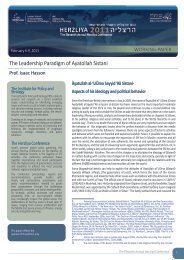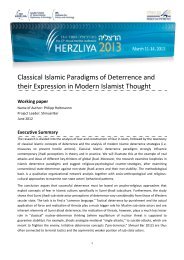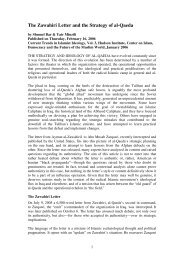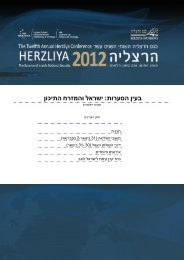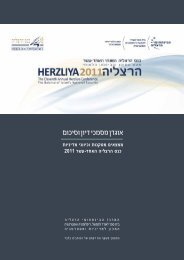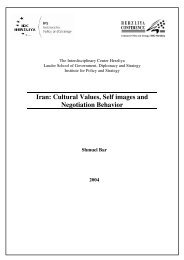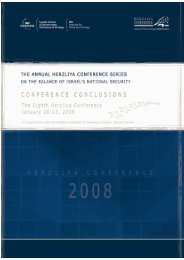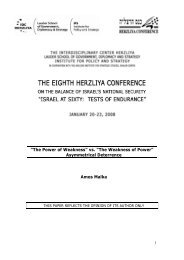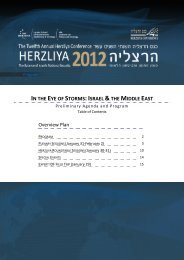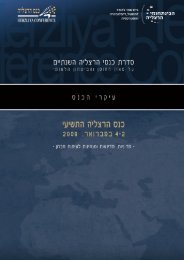Bashar’s <strong>Syria</strong> 409conflict with Israel. It was also a theatre for airing internal <strong>Syria</strong>n power struggles<strong>and</strong> for various individuals within the regime to strengthen their own status. <strong>The</strong>strategic importance of Lebanon, in a way, “rubbed off” on those senior <strong>Syria</strong>nswhose task it was to maintain it. Thus, disputes between Ghazi Kana’an <strong>and</strong>Mustafa Tlas first were aired in the Lebanese arena.• Personal prestige. Bashar presided over the “Lebanese File” <strong>and</strong> was personallyinvolved in the election of Lahoud as President of Lebanon. <strong>Syria</strong>n domination overLebanon—<strong>and</strong> the Arab legitimation of that domination—arguably was amongHafez al-Asad’s major strategic achievements. To lose that asset would be a blowto Bashar’s prestige.<strong>The</strong> <strong>Syria</strong>n domination of Lebanon was based on a number of instruments: Diplomatic agreements. <strong>The</strong>se included the Treaty of Brotherhood, Cooperation,<strong>and</strong> Coordination between Lebanon <strong>and</strong> <strong>Syria</strong> (May 20, 1991) in which the twoagreed “to achieve the highest level of cooperation <strong>and</strong> coordination in all political,economic, security . . . as an affirmation of the brotherly relations <strong>and</strong> guarantee oftheir common destiny.” This treaty was augmented by the Lebanon-<strong>Syria</strong> Defense<strong>and</strong> Security Agreement (September 1 1991), which formalized the domination of<strong>Syria</strong>’s military <strong>and</strong> security services in Lebanon. Two years later, an Agreement forEconomic <strong>and</strong> Social Cooperation <strong>and</strong> Coordination outlined a program of economicintegration which, in practice, made Lebanon an outlet for <strong>Syria</strong>n goods <strong>and</strong> labor. Military occupation. This effectively was terminated in the wake of the “CedarRevolution” of Spring 2005. Security involvement. According to current information, <strong>Syria</strong> still maintains anintelligence presence in Lebanon under the guise of the Lebanese security services,which are still loyal to Damascus. Economic domination. This is partially formal, a result of the Agreement for Economic<strong>and</strong> Social Cooperation <strong>and</strong> Coordination, <strong>and</strong> partially due to the economicinvolvement of senior <strong>Syria</strong>n figures (including Maher al-Asad, Ghazi Kana’an,Rustum Ghazaleh, <strong>and</strong> Rami Makhluf). Political engineering. In the wake of defeats of pro-<strong>Syria</strong>n c<strong>and</strong>idates in municipalelections in 1998, a new electoral law was promulgated which gerrym<strong>and</strong>eredLebanon in a manner that neutralized most of the anti-<strong>Syria</strong>n elements. 133 <strong>Syria</strong> alsopressured the Lebanese Parliament into extending the six-year term of President Lahoudby three years (3 Septemeber 2004), a step that precipitated UNSC resolution1559, which called for a <strong>Syria</strong>n exit from Lebanon.<strong>The</strong> <strong>Syria</strong>n vision for future relations with Lebanon clearly was a continuation of the<strong>Syria</strong>n domination of the country at minimum, <strong>and</strong> possibly a closer formal relationship.<strong>The</strong> <strong>Syria</strong>n slogan of “one people in two states” is reminiscent of the Chinese proposalsfor Hong Kong <strong>and</strong> Taiwan (one country, two systems). <strong>The</strong> rise of Bashar, who wasperceived as less capable of holding on to <strong>Syria</strong>’s strategic assets in Lebanon <strong>and</strong> elsewhere,galvanized <strong>Syria</strong>’s traditional opponents in the country. <strong>The</strong> feeling that <strong>Syria</strong> had madeShi’ite Hezbollah <strong>its</strong> main ally in the country (after Lahoud) 134 created a coalition of Sunnis<strong>and</strong> Christians (who had lost their former predominance), <strong>and</strong> Druze (whose leader, WalidJoumblat, has a blood account with the Asads because of the assassination of his father at<strong>Syria</strong>’s h<strong>and</strong>s). This coalition found a formidable leader in Rafiq al-Hariri who had his closelinks to France <strong>and</strong> Saudi Arabia. In the wake of the American invasion of Iraq, internationalcircumstances favored change <strong>and</strong> allowed for UNSC 1559.
410 S. <strong>Bar</strong>Bashar did not read these signals of change <strong>and</strong> continued to try to manipulate theLebanese theater as <strong>Syria</strong> had done for over two decades (see discussion below on thedecision-making process in Bashar’s regime). According to numerous accounts, Basharwas also slow to read the portents of the Lebanese “Cedar Revolution” that broke out inthe wake of the assassination of al-Hariri. <strong>The</strong> <strong>Syria</strong>n response to these new currents inLebanon was to activate <strong>its</strong> proxies in the Lebanese theater in order to thwart calls for a<strong>Syria</strong>n withdrawal <strong>and</strong> silence those who dared to incriminate <strong>Syria</strong> in the assassination.This was done through a series of murders (or attempted murders) of critics of <strong>Syria</strong> 135<strong>and</strong> pro-<strong>Syria</strong>n demonstrations, mainly organized by Hezbollah. <strong>The</strong>se acts were, however,counterproductive, as they generated more anti-<strong>Syria</strong>n sentiment <strong>and</strong> an escalation of thedem<strong>and</strong> for an immediate <strong>Syria</strong>n withdrawal from the country. <strong>The</strong> failure of these attempts<strong>and</strong> the declared willingness of the main <strong>Syria</strong>n proxy in Lebanon, Hezbollah, to negotiatedisarming <strong>its</strong>elf were indications of the decline of the <strong>Syria</strong>n influence in this arena.Another salient case in point can be found in the volatile arena of <strong>Syria</strong>’s policy regardingLebanon. <strong>The</strong> jury is still out as to whether Bashar himself was involved in ordering themurder of al-Hariri, or in the subsequent murders of prominent Lebanese dissidents SamirKassir <strong>and</strong> George Hawi in June 2005. Bashar’s dislike of al-Hariri was no secret to hisinner circle—or to the general public. As the situation in Lebanon became more <strong>and</strong> morehostile to <strong>Syria</strong>n interests <strong>and</strong> this trend was linked in the eyes of the <strong>Syria</strong>n regime to thepolitical mechanizations of al-Hariri, it became clear to the inner circles of the regime thatthe al-Hariri “problem” had to be dealt with. It is also not disputed that the escalation ofthe <strong>Syria</strong>n conflict with al-Hariri did not escape the eyes of other international <strong>and</strong> regionalactors, <strong>and</strong> France <strong>and</strong> Saudi Arabia even cautioned Bashar not to harm al-Hariri. Underthese circumstances, the <strong>Syria</strong>n leadership could have assumed that France, Saudi Arabia,<strong>and</strong> the United States would not take an assassination kindly. Under the regime of Hafezal-Asad, the impossibility of plausible deniability would have precluded any senior officialtaking it upon himself to eliminate a prominent Lebanese politician with close ties to theUnited States, Saudi Arabia, <strong>and</strong> France.<strong>The</strong> various scenarios offered for the development of the al-Hariri affair are distinguishedin their depictions of the degree of control held by Bashar. <strong>The</strong>se scenarios include: Over delegation of authority: <strong>The</strong> Bashar regime had lost <strong>its</strong> presidential “safetylatch” <strong>and</strong> had not replaced it with an alternative set of checks <strong>and</strong> balances. Consequently,according to this scenario, senior figures in the regime (those alluded toin the Mehlis report are Asef Shawkat <strong>and</strong> Maher al-Asad), acted upon their ownauthority <strong>and</strong> underst<strong>and</strong>ing of <strong>Syria</strong>n interests <strong>and</strong> did not feel the need for explicitorder. “Peer pressure”: According to this version, Bashar held consultations with his securityadvisors, who opted for elimination of al-Hariri. Bashar, as a “democraticleader,” accepted the verdict. Many Lebanese even claim to “know” that Bashar waspersonally involved in giving the order, while others claim that he <strong>and</strong> Ghazi Kana’anopposed the assassination, while Maher al-Asad <strong>and</strong> Asaf Shawkat were in favor ofit. Obviously, no one can provide proof for these claims. <strong>The</strong> decline of the old guard: <strong>The</strong> experienced <strong>and</strong> cautious old guard had lost mostof <strong>its</strong> clout within the regime <strong>and</strong> the assassination was the result of the rise of youngofficers in the intelligence community <strong>and</strong> neophytes surrounding Bashar, who lackthe discretion of their predecessors. Loss of control: This explanation is based on the fact that Bashar already had deposedmany of the old guard <strong>and</strong> many of them continued to maintain their links
- Page 4 and 5:
Bashar’s Syria 355of political im
- Page 8 and 9: Bashar’s Syria 359a-Zur province
- Page 11: 362 S. Barof Lebanon, with which Sy
- Page 17 and 18: 368 S. Barnaturally come with the s
- Page 19 and 20: 370 S. BarSimilar behavior on the p
- Page 21 and 22: 372 S. Bardemocracy” must be foun
- Page 23 and 24: 374 S. Barcultural, political and m
- Page 25 and 26: 376 S. Barexcept for those with fam
- Page 27 and 28: 378 S. Barthe provisions for nonpro
- Page 29 and 30: 380 S. Bar The ups and downs in rel
- Page 31 and 32: 382 S. Barfamily is also linked by
- Page 33 and 34: 384 S. Bar2. The “second generati
- Page 35 and 36: 386 S. BarThe reformist trend withi
- Page 37 and 38: 388 S. Barwould allow the younger g
- Page 39 and 40: 390 S. BarFigure 3. Heads of the Sy
- Page 41 and 42: 392 S. Bar Disruption of the “hie
- Page 43 and 44: 394 S. Bar(Majlis Milli), composed
- Page 45 and 46: 396 S. Bar Other prominent Syrians
- Page 47 and 48: 398 S. BarSyrian civil society—su
- Page 49 and 50: 400 S. BarMany of the Muslim Brothe
- Page 51 and 52: 402 S. BarThese elements find reson
- Page 53 and 54: 404 S. BarIran’s proxy, Hezbollah
- Page 55 and 56: 406 S. BarWest—and specifically t
- Page 57: 408 S. BarBashar is well aware that
- Page 61 and 62: 412 S. Bartoken withdrawal while ma
- Page 63 and 64: 414 S. Barlegitimacy had eroded. Ne
- Page 65 and 66: 416 S. Barin the wake of the al-Har
- Page 67 and 68: 418 S. BarIt was Russia, however, t
- Page 69 and 70: 420 S. Baror so, with competitive p
- Page 71 and 72: 422 S. Bar10. According to the well
- Page 73 and 74: 424 S. Bar44. See Flynt Everett, In
- Page 75 and 76: 426 S. Barinternet news site, all4s
- Page 77 and 78: 428 S. Bar100. As one Sunni Syrian
- Page 79 and 80: 430 S. Bar125. Radio Damascus, 21 O
- Page 81 and 82: 432 S. BarBengio, Ofra and Gabriel
- Page 83 and 84: 434 S. BarNews agencies and Newspap
- Page 85 and 86: Regional Command;Central CommitteeR
- Page 87 and 88: Main Figures in the Syrian Ba’th
- Page 89 and 90: Main Figures in the Syrian Ba’th
- Page 91 and 92: Main Figures in the Syrian Ba’th
- Page 93 and 94: Main Figures in the Syrian Ba’th



